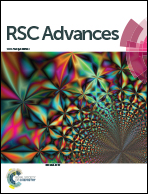An efficient route to asymmetrically diconjugated tris(heteroleptic) complexes of Ru(ii)†
Abstract
A highly efficient and versatile route to the preparation of tris(heteroleptic) Ru(II) polypyridyl complexes is described which permits access to two or more independently conjugatable termini in the final structure. The strategy utilizes the well-known Ru(DMSO)4Cl2 precursor to form the Ru(N^N)(DMSO)2Cl2 product and then proceeds through an oxalate intermediate which can be cleaved under acidic conditions to control the stoichiometric addition of polypyridyl ligands to the Ru(II) coordination sphere enabling the stepwise assembly of the heteroleptic complex. To exemplify this approach, three complexes were prepared including the novel: [Ru(dppz)(bpyArCOOH)(bpyArCOOEt)]2+ (where dppz is dipyridophenazine, bpyArCOOH and bpyArCOOEt are 4-(4-carboxyphenyl)- and 4-(4-ethoxycarbonylphenyl)-2,2-bipyridine, respectively) in which the synthetic yield from the RuCl3 starting material to final product is 82%. A sequential conjugation–deprotection–conjugation step is then described to yield a Ru(II) complex which is both PEGylated and peptide-conjugated. This synthetic approach offers a useful means to expand the structural diversity of bis coordinated Ru(II) polypyridyl complexes and provides a simple route to building multifunctionality into such complexes which should broaden their applications, in particular in the domain of bioimaging and therapy.


 Please wait while we load your content...
Please wait while we load your content...